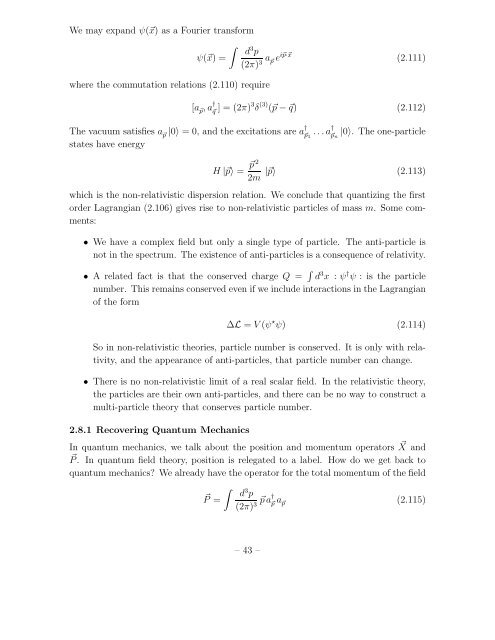Quantum Field Theory
Quantum Field Theory
Quantum Field Theory
Create successful ePaper yourself
Turn your PDF publications into a flip-book with our unique Google optimized e-Paper software.
We may expand ψ(⃗x) as a Fourier transform∫ψ(⃗x) =where the commutation relations (2.110) required 3 p(2π) 3 a ⃗p ei⃗p·⃗x (2.111)[a ⃗p , a † ⃗q ] = (2π)3 δ (3) (⃗p − ⃗q) (2.112)The vacuum satisfies a ⃗p|0〉 = 0, and the excitations are a † ⃗p 1. . .a † ⃗p n|0〉. The one-particlestates have energyH |⃗p〉 = ⃗p 22m|⃗p〉 (2.113)which is the non-relativistic dispersion relation. We conclude that quantizing the firstorder Lagrangian (2.106) gives rise to non-relativistic particles of mass m. Some comments:• We have a complex field but only a single type of particle. The anti-particle isnot in the spectrum. The existence of anti-particles is a consequence of relativity.• A related fact is that the conserved charge Q = ∫ d 3 x : ψ † ψ : is the particlenumber. This remains conserved even if we include interactions in the Lagrangianof the form∆L = V (ψ ⋆ ψ) (2.114)So in non-relativistic theories, particle number is conserved. It is only with relativity,and the appearance of anti-particles, that particle number can change.• There is no non-relativistic limit of a real scalar field. In the relativistic theory,the particles are their own anti-particles, and there can be no way to construct amulti-particle theory that conserves particle number.2.8.1 Recovering <strong>Quantum</strong> MechanicsIn quantum mechanics, we talk about the position and momentum operators ⃗ X and⃗P. In quantum field theory, position is relegated to a label. How do we get back toquantum mechanics? We already have the operator for the total momentum of the field∫⃗P =d 3 p(2π) 3 ⃗pa† ⃗p a ⃗p (2.115)– 43 –
















